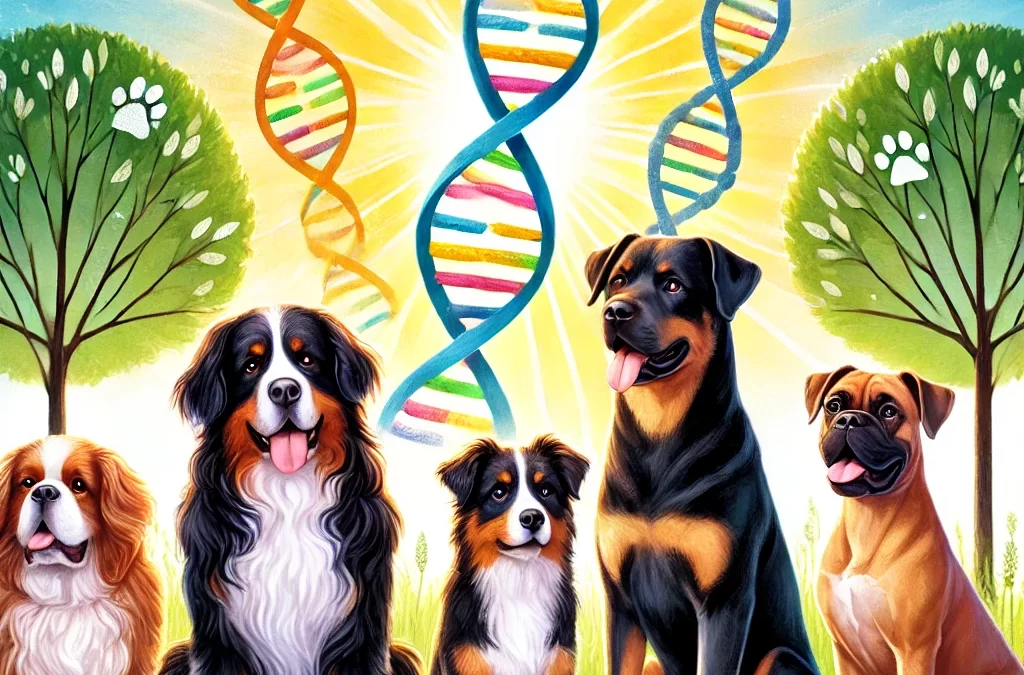
von TCMVET | 6. Dez. 2024 | Krebs und Tumore bei Hunden
Wenn bei einem geliebten Haustier Krebs diagnostiziert wird, kann das für jeden Tierbesitzer eine Herausforderung sein. Die Suche nach den richtigen Behandlungsmöglichkeiten und Nahrungsergänzungsmitteln ist entscheidend, um das Wohlbefinden und die Lebensqualität des Tieres zu gewährleisten. Unter den unzähligen online verfügbaren Nahrungsergänzungsmitteln für Haustiere gegen Krebs finden Sie TCMVET Baituxiao zeichnet sich als natürliche, wirksame Option zur Kontrolle und Bekämpfung des Tumorwachstums bei Hunden und Katzen aus.
Die Rolle von Krebsergänzungsmitteln in der Haustierpflege verstehen
Krebs bei Haustieren führt häufig zu körperlichen Beschwerden, vermindertem Energieniveau und verminderter Immunität. Konventionelle Behandlungen wie Operationen, Chemotherapie oder Bestrahlung können zwar wirksam sein, sind jedoch häufig mit hohen Kosten und potenziellen Nebenwirkungen verbunden. Hier können natürliche Nahrungsergänzungsmittel eine unterstützende Rolle spielen und darauf abzielen:
- Stärken Sie das Immunsystem.
- Langsames Tumorwachstum.
- Verbessern Sie Ihr allgemeines Wohlbefinden und Ihr Energieniveau.
- Reduziert Entzündungen und Beschwerden.
Durch die Kombination traditioneller Therapien mit wissenschaftlich fundierten Nahrungsergänzungsmitteln geben Sie Ihrem Haustier die besten Chancen auf ein gesünderes und angenehmeres Leben.
Was ist TCMVET Baituxiao?
TCMVET Baituxiao ist eine spezielle Kräuterformel, die auf den Prinzipien der Traditionellen Chinesischen Medizin (TCM) basiert. Es wurde speziell für Haustiere entwickelt und nutzt die Kraft natürlicher Inhaltsstoffe, um:
- Reduziert das Tumorwachstum: Seine einzigartige Mischung zielt auf die abnormale Zellvermehrung ab und hilft, das Tumorwachstum zu verlangsamen.
- Unterstützt die allgemeine Gesundheit: Mit seinen immunstärkenden Eigenschaften stärkt es die natürlichen Abwehrkräfte Ihres Haustiers.
- Symptome lindern: Baituxiao kann Entzündungen reduzieren und die Energie steigern, sodass Ihr Haustier aktiv und glücklich bleibt.
Warum sollten Sie sich für TCMVET Baituxiao entscheiden?
- Natürliche Zutaten: Frei von synthetischen Zusatzstoffen, verwendet Baituxiao pflanzliche Bestandteile, die sanft zum Körper Ihres Haustiers sind.
- Von Tierärzten zugelassen: Viele Tierärzte unterstützen den Einsatz als Teil eines integrierten Behandlungsplans für Haustiere mit Tumoren.
- Wissenschaftlich formuliert: TCMVET Baituxiao kombiniert moderne Forschung mit TCM-Expertise und ist sorgfältig auf Sicherheit und Wirksamkeit ausgelegt.
So verwenden Sie TCMVET Baituxiao
Die Anwendung von TCMVET Baituxiao ist einfach und bequem. Es kann oral verabreicht oder zur einfachen Einnahme mit dem Futter vermischt werden. Die Dosierung wird je nach Größe und spezifischen Gesundheitsbedürfnissen Ihres Haustiers angepasst, um optimale Ergebnisse zu gewährleisten. Konsultieren Sie immer Ihren Tierarzt, bevor Sie Ihrem Haustier ein neues Ergänzungsmittel geben.
Wo kann man TCMVET Baituxiao online kaufen?
Sie können TCMVET Baituxiao bequem online über Plattformen wie kaufen Amazonas, Shopifyoder direkt über die TCMVET-Website. Mit schnellen Versandoptionen, einschließlich der Abwicklung aus Amazon-Lagern, können Sie die Reise Ihres Haustiers zu besserer Gesundheit schnell und problemlos beginnen.
Erfahrungsberichte von Tierbesitzern
Tierbesitzer, die TCMVET Baituxiao verwendet haben, erzählen oft herzerwärmende Erfolgsgeschichten. Viele berichten von spürbaren Verbesserungen des Energieniveaus ihrer Haustiere, einer Verringerung der Tumorgröße und einer höheren Lebensqualität.
Tipps zur Auswahl des richtigen Nahrungsergänzungsmittels für Haustiere bei Krebs
Beachten Sie Folgendes, wenn Sie online nach wirksamen Nahrungsergänzungsmitteln gegen Krebs suchen:
- Sicherheit und Inhaltsstoffe: Entscheiden Sie sich für Produkte mit natürlichen, für Haustiere sicheren Inhaltsstoffen.
- Bewertungen und Empfehlungen: Suchen Sie nach Feedback von anderen Tierbesitzern.
- Einfache Verwaltung: Wählen Sie Nahrungsergänzungsmittel, die Sie Ihrem Haustier leicht verabreichen können.
- Fachkundige Beratung: Fragen Sie Ihren Tierarzt, um sicherzustellen, dass das Ergänzungsmittel zum Behandlungsplan Ihres Haustiers passt.
Abschluss
Der Umgang mit einer Krebsdiagnose bei Haustieren ist nie einfach, aber mit den richtigen Werkzeugen und Ergänzungsmitteln wie TCMVET Baituxiaokönnen Sie Ihrem Haustier Komfort, Pflege und verbessertes Wohlbefinden bieten. Indem Sie wirksame Krebspräparate online kaufen, können Sie einen proaktiven Schritt zur Gesundheitsversorgung Ihres Haustiers unternehmen. Entdecken Sie TCMVET Baituxiao noch heute und sehen Sie, welchen Unterschied es für Ihren pelzigen Freund machen kann.

von TCMVET | 6. Dez. 2024 | Krebs und Tumore bei Hunden
Eierstockkrebs bei Hunden ist ein seltener und oft stiller Eindringling, der sich unauffällig in das Leben unserer geliebten Haustiere einschleicht. Im Gegensatz zu häufigeren Krebsarten bei Hunden zeigt Eierstockkrebs im Frühstadium nicht immer offensichtliche Symptome, sodass er selbst für die aufmerksamsten Tierbesitzer schwer zu erkennen ist. Dieser Artikel befasst sich eingehend mit diesem wenig diskutierten Thema und beleuchtet die Symptome und Frühwarnzeichen, die jeder Hundebesitzer kennen sollte.
Eierstockkrebs bei Hunden verstehen
Eierstockkrebs entsteht durch abnormales Wachstum in den Eierstöcken, häufig bei unkastrierten Hündinnen mittleren oder höheren Alters. Die Erkrankung ist selten, da die Sterilisation immer häufiger praktiziert wird, was das Risiko deutlich senkt. Für unkastrierte Hündinnen bleibt die Gefahr jedoch bestehen – ein stiller Räuber lauert in ihnen.
Frühe Symptome: Das Flüstern der Krankheit
Die Symptome von Eierstockkrebs überschneiden sich häufig mit anderen Gesundheitsproblemen, was eine Früherkennung schwierig macht. Hier sind die subtilen Anzeichen, die auf ein tieferes Problem hinweisen könnten:
- Abnormale Hitzezyklen
Wenn der Östruszyklus Ihrer Hündin unregelmäßig wird, sich verlängert oder unerwartet endet, könnte dies auf Anomalien der Eierstöcke hinweisen.
- Vergrößerter Bauch
Flüssigkeitsansammlungen (Aszites) oder ein wachsender Tumor können zu einer auffälligen Schwellung im Bauch Ihres Hundes führen.
- Verhaltensänderungen
Lethargie, Reizbarkeit oder Ruhelosigkeit können auf Unbehagen oder Schmerzen hinweisen, die durch innere Veränderungen verursacht werden.
- Loss of Appetite and Weight
Ein Mangel an Interesse am Essen, gepaart mit unerklärlichem Gewichtsverlust, ist oft ein frühes Warnzeichen.
- Ausfluss oder Blutung
Vaginaler Ausfluss, insbesondere wenn er ungewöhnlich ist oder außerhalb des normalen Hitzezyklus auftritt, erfordert sofortige tierärztliche Behandlung.
Fortgeschrittene Symptome: Wenn die Stille bricht
Mit Fortschreiten des Eierstockkrebses können deutlichere und schwerwiegendere Symptome auftreten:
- Atembeschwerden: Diese können auftreten, wenn der Krebs in die Lunge metastasiert.
- Lahmheit: Ein Zeichen für Metastasen in den Knochen.
- Sichtbare Massen: Tastbare Wucherungen im Bauchraum oder in den umliegenden Bereichen.
- Starke Lethargie und Schwäche: Anzeichen einer systemischen Ausbreitung und nachlassenden Gesundheit.
Diagnose: Die Bedeutung einer Früherkennung
Eierstockkrebs lässt sich am effektivsten durch eine Kombination aus bildgebenden Verfahren (Ultraschall oder Röntgen) und Bluttests diagnostizieren. Eine Biopsie oder Feinnadelaspiration verdächtiger Tumore kann das Vorhandensein von Krebs bestätigen. Regelmäßige tierärztliche Untersuchungen, insbesondere bei unkastrierten Hunden, sind für eine Früherkennung von entscheidender Bedeutung.
Vorbeugung und Kastration: Ein lebensrettender Schritt
Die effektivste Methode, Eierstockkrebs bei Hunden vorzubeugen, ist die Kastration. Dadurch wird nicht nur das Risiko von Eierstockkrebs eliminiert, sondern auch das Risiko anderer Krebserkrankungen und Krankheiten der Fortpflanzungsorgane, wie z. B. Pyometra, verringert.
Ganzheitliche Betreuung bei Krebs bei Hunden
Bei Hunden mit Eierstockkrebs kann eine ganzheitliche Betreuung konventionelle Behandlungen wie Operationen, Chemotherapie oder Bestrahlung ergänzen. Entzündungshemmende Diäten, immunstärkende Nahrungsergänzungsmittel und stressreduzierende Therapien können die Lebensqualität Ihres Haustiers verbessern.
- Pflanzliche Unterstützung: Erwägen Sie Nahrungsergänzungsmittel wie Kurkuma oder Mariendistel, die für ihre entzündungshemmenden und entgiftenden Eigenschaften bekannt sind.
- Ernährungsumstellungen: Eine proteinreiche, kohlenhydratarme Ernährung kann das Krebswachstum verlangsamen.
- Emotionale Betreuung: Unterschätzen Sie in dieser schwierigen Zeit niemals die Kraft von Liebe, Aufmerksamkeit und Trost.
Die unerschütterliche Bindung
Die Diagnose Eierstockkrebs bei Hunden kann zwar herzzerreißend sein, ist aber auch eine ergreifende Erinnerung an die tiefe Bindung, die wir mit unseren pelzigen Gefährten haben. Jedes Symptom, jedes Anzeichen und jede Handlung, die wir unternehmen, ist ein Beweis für die bedingungslose Liebe, die unsere Beziehung zu ihnen ausmacht.
Wenn wir die subtilen Anzeichen von Eierstockkrebs verstehen und proaktive Maßnahmen ergreifen, können wir unsere Hundegefährten besser schützen und sicherstellen, dass sie ein glückliches und gesundes Leben führen. Schließlich verdienen sie nichts weniger als unser Allerbestes.

von TCMVET | 5. Dez. 2024 | Krebs und Tumore bei Hunden
Abnorme Wucherungen im unteren Darmbereich eines Hundes können erhebliche gesundheitliche Probleme verursachen, die von Beschwerden bis hin zu lebensbedrohlichen Zuständen reichen. Diese Wucherungen, die sich oft im Rektum oder Dickdarm befinden, können gutartig oder bösartig sein. Das Verständnis ihrer Ursachen, Symptome und Behandlungsmöglichkeiten ist entscheidend für ein rechtzeitiges Eingreifen.
Häufige Arten von Wucherungen
- Polypen
- Polypen sind gutartige Wucherungen, die sich in der Darmschleimhaut entwickeln.
- Sie können leichte Blutungen, Durchfall oder Verstopfung verursachen.
- Unbehandelt können sich Polypen manchmal in bösartige Tumoren verwandeln.
- Adenokarzinom
- Ein bösartiger Tumor, der die Drüsenzellen der Darmschleimhaut befällt.
- Es handelt sich um eine der aggressivsten Formen von Darmkrebs.
- Für eine wirksame Behandlung ist eine frühzeitige Erkennung von entscheidender Bedeutung.
- Leiomyosarkom
- Eine seltene Krebsart, die in der glatten Muskulatur des Darms entsteht.
- Es kann zu Verstopfungen und schweren Verdauungsproblemen führen.
- Hämangiome und Hämangiosarkome
- Diese Gefäßtumoren können entweder gutartig (Hämangiome) oder bösartig (Hämangiosarkome) sein.
- Sie führen häufig zu Blutungen und Anämie.
Symptome von abnormalem Wachstum
Hunde mit abnormalem Wachstum im unteren Darmbereich können folgende Symptome aufweisen:
- Blut im Stuhl: Hellroter oder teerartig schwarzer Stuhl.
- Anstrengung beim Stuhlgang: Schwierigkeiten oder Schmerzen beim Stuhlgang.
- Veränderungen der Stuhlform: Schmaler oder bandförmiger Stuhl aufgrund einer Verstopfung.
- Durchfall oder Verstopfung: Anhaltende Veränderungen der Stuhlgewohnheiten.
- Weight Loss: Unerklärlicher Gewichts- und Appetitverlust.
- Erbrechen oder Lethargie: Anzeichen für Magen-Darm-Beschwerden.
Ursachen und Risikofaktoren
Die genaue Ursache für abnormales Wachstum ist unterschiedlich. Zu den beitragenden Faktoren gehören unter anderem:
- Diät: Eine minderwertige oder verarbeitete Ernährung kann zur Entzündung und Tumorbildung beitragen.
- Alter und Genetik: Ältere Hunde und bestimmte Rassen wie Boxer und Deutsche Schäferhunde sind anfälliger für Darmtumore.
- Chronische Entzündung: Erkrankungen wie Kolitis können bei Hunden zu Wucherungen führen.
- Belastung mit Giftstoffen: Umweltgifte und Karzinogene können das Krebsrisiko erhöhen.
Diagnose
Tierärzte verwenden eine Kombination von Methoden, um Darmtumoren zu diagnostizieren:
- Körperliche Untersuchung: Palpation zur Identifizierung von Massen.
- Bildgebung: Röntgen-, Ultraschall- oder CT-Scans zur Visualisierung von Wucherungen.
- Endoskopie: Einführen einer Kamera zur Untersuchung des Darms und Entnahme von Gewebeproben.
- Biopsie: Laboranalyse des Gewebes, um festzustellen, ob das Wachstum gutartig oder bösartig ist.
Behandlungsmöglichkeiten
Das Behandlungskonzept richtet sich nach der Art und Schwere der Wucherung:
- Operative Entfernung: Polypen und lokale Tumoren können oft operativ entfernt werden.
- Chemotherapie oder Strahlentherapie: Wird bei bösartigen Wucherungen, insbesondere Adenokarzinomen, eingesetzt.
- Ernährungsmanagement: Ballaststoffreiche oder verschreibungspflichtige Diäten zur Linderung der Symptome.
- Palliativpflege: Schmerzlinderung und Lebensqualitätsmanagement für fortgeschrittene Fälle.
Prävention und Überwachung
- Regelmäßige Kontrolluntersuchungen: Regelmäßige Tierarztbesuche können helfen, Wucherungen frühzeitig zu erkennen.
- Healthy Diet: Eine Ernährung, die reich an natürlichen, hochwertigen Zutaten ist, kann Entzündungen lindern.
- Screening bei gefährdeten Rassen: Regelmäßige Untersuchungen für Rassen, die anfällig für Darmprobleme sind.
Wann Sie einen Tierarzt aufsuchen sollten
Wenn Ihr Hund Anzeichen von Rektalblutungen, chronischen Verdauungsproblemen oder deutlichen Veränderungen im Stuhlgang zeigt, sollten Sie unbedingt umgehend einen Tierarzt aufsuchen. Eine frühzeitige Diagnose und Behandlung kann die Ergebnisse erheblich verbessern.
Indem sie informiert bleiben und proaktiv handeln, können Tierbesitzer die Gesundheit ihrer Hunde besser schützen und potenzielle Probleme angehen, bevor sie eskalieren.

von TCMVET | 5. Dez. 2024 | Krebs und Tumore bei Hunden
Krebs ist nach wie vor eine der häufigsten Todesursachen bei Hunden weltweit. Während die genetische Veranlagung oft im Mittelpunkt der Diskussionen steht, zeigt eine genauere Untersuchung, dass Umweltfaktoren eine weitaus größere Rolle spielen könnten als bisher angenommen. Lassen Sie uns tiefer in dieses Thema eintauchen und einige überraschende Wahrheiten über die tatsächlich häufigste Ursache für Krebs bei Hunden aufdecken.
Über die Genetik hinaus: Umwelteinflüsse stehen im Mittelpunkt
Es ist einfach, die Ursache für Krebs auf die Genetik zu schieben. Schließlich sind bestimmte Rassen wie Golden Retriever und Boxer anfälliger für Krebserkrankungen wie Lymphome oder Mastzelltumoren. Experten weisen jedoch zunehmend darauf hin, Umweltkarzinogene als Hauptursache für Krebs bei Hunden. Dazu gehören:
- Chemische Belastung: Pestizide, Herbizide und Haushaltsreiniger setzen Hunde täglich schädlichen Chemikalien aus. Viele dieser Substanzen enthalten Karzinogene, die sich im Laufe der Zeit im Körper ansammeln können.
- Verarbeitete Diäten: Trockenfutter und Dosenfutter enthalten oft Konservierungsstoffe, künstliche Farbstoffe und minderwertige Zutaten, die langfristig zu Entzündungen und Zellschäden beitragen können.
- Luftverschmutzung: Hunde atmen aufgrund ihres ausgeprägten Geruchssinns mehr Umweltgifte ein als Menschen. Verschmutzte Luft, Zigarettenrauch und Autoabgase sind nur einige der Übeltäter.
- Überimpfung: Obwohl Impfungen unerlässlich sind, wird eine Überimpfung mit bestimmten Krebsarten in Verbindung gebracht, beispielsweise mit Sarkomen an der Injektionsstelle. Es ist wichtig, den Impfplan an die spezifischen Bedürfnisse Ihres Hundes anzupassen.
Entzündung: Der stille Katalysator
Chronische Entzündungen sind ein weiterer kritischer Faktor. Von unbehandelten Allergien bis hin zu Fettleibigkeit schaffen Entzündungen den perfekten Nährboden für das Gedeihen von Krebszellen. Dies unterstreicht die Bedeutung eines ganzheitlichen Ansatzes für die Gesundheit von Hunden, der sowohl physische als auch umweltbedingte Stressfaktoren berücksichtigt.
Vorbeugen ist die beste Medizin
Wenn Umwelteinflüsse die häufigste Ursache für Krebs bei Hunden sind, sind Präventionsstrategien unsere beste Verteidigung. So können Tierbesitzer Maßnahmen ergreifen:
- Umstellung auf natürliche Ernährung: Entscheiden Sie sich für frische, vollwertige Lebensmittel ohne Konservierungsstoffe. Integrieren Sie krebsbekämpfende Zutaten wie Kurkuma, Blaubeeren und Brokkoli in die Ernährung Ihres Hundes.
- Filtern Sie ihr Wasser: Stellen Sie gefiltertes Wasser bereit, um die Belastung durch Schwermetalle und Giftstoffe zu verringern.
- Begrenzen Sie den Einsatz von Chemikalien: Ersetzen Sie giftige Reinigungsprodukte durch haustiersichere Alternativen und reduzieren Sie den Einsatz von Pestiziden in Ihrem Haus und Garten.
- Routinemäßige Entgiftung: Erwägen Sie natürliche Entgiftungsmittel wie Mariendistel oder Chlorella, um Giftstoffe aus dem Körper Ihres Hundes zu entfernen.
- Regelmäßige Kontrolluntersuchungen: Früherkennung ist der Schlüssel. Führen Sie monatlich Kontrollen auf Knoten und abnormale Wucherungen durch und gehen Sie einmal im Jahr zu Ihrem Tierarzt, um gründliche Untersuchungen durchführen zu lassen.
Die Rolle der ganzheitlichen Medizin
Natürliche Therapien erfreuen sich bei Hundebesitzern, die Krebs bekämpfen wollen, zunehmender Beliebtheit. Von Akupunktur bis hin zu pflanzlichen Nahrungsergänzungsmitteln wie TCMVET Baituxiaozielen diese Behandlungen darauf ab, Entzündungen zu reduzieren, das Immunsystem zu stärken und das allgemeine Wohlbefinden zu fördern. Solche Ansätze bieten in Kombination mit Änderungen des Lebensstils eine vielversprechende Möglichkeit, Krebs bei Hunden vorzubeugen und zu behandeln.
Ein Aufruf zum Handeln: Schutz unserer besten Freunde
Als Betreuer haben wir die Möglichkeit, die Belastung unserer Hunde durch krebserregende Faktoren zu minimieren. Indem wir uns auf Prävention, Ernährung und natürliche Therapien konzentrieren, können wir das Krebsrisiko deutlich senken und das Leben unserer pelzigen Gefährten verlängern. Lassen Sie uns die Initiative ergreifen, alte Überzeugungen in Frage stellen, neue Praktiken übernehmen und das Wohlergehen unserer geliebten Haustiere schützen.

von TCMVET | 4. Dez. 2024 | Krebs und Tumore bei Hunden
Herzbasistumore werden zwar seltener thematisiert als andere Krebsarten bei Hunden, stellen aber für betroffene Hunde eine erhebliche gesundheitliche Herausforderung dar. Diese Tumore entstehen in der Nähe der Herzbasis und bleiben oft unentdeckt, bis sie groß genug sind, um die Herzfunktion zu beeinträchtigen. Das Verständnis dieser stillen, aber ernsten Erkrankung kann Hundebesitzern helfen, proaktiv Schritte zur Diagnose und Behandlung zu unternehmen.
Was sind Herzbasistumoren?
Herzbasistumore sind Wucherungen, die sich in oder um die Basis des Herzens bilden, typischerweise in der Nähe lebenswichtiger Strukturen wie der Aorta oder der Lungenarterie. Die beiden häufigsten Arten sind:
- Chemodektome (Paragangliome): Langsam wachsende Tumoren, die aus Chemorezeptorzellen entstehen, die den Sauerstoffgehalt im Blut regulieren.
- Ektopische Schilddrüsentumoren: Seltene Tumoren, die aus herznahem Schilddrüsengewebe entstehen.
Beide Arten können das Herz oder angrenzende Strukturen komprimieren und so zu erheblichen kardiovaskulären Komplikationen führen.
Rassen mit einer Prädisposition für Herzbasistumore
Obwohl jeder Hund diese Tumore entwickeln kann, sind bestimmte Rassen aufgrund einer genetischen Veranlagung anfälliger. Dazu gehören:
- Boxer
- Bulldoggen
- Boston Terrier
Bei diesen Rassen treten die Symptome oft erst später im Leben auf, wobei die Erkrankung häufig bei mittelalten bis älteren Hunden diagnostiziert wird.
Anzeichen und Symptome: Die subtilen Warnungen
Herzbasistumore sind im Frühstadium oft symptomlos, was eine Früherkennung schwierig macht. Wenn sie jedoch wachsen, können die folgenden Symptome auftreten:
- Belastungsintoleranz: Schwierigkeiten bei der Durchführung von Aktivitäten, die dem Hund früher Spaß gemacht haben.
- Husten: Verursacht durch Flüssigkeitsansammlung oder Druck auf die Luftröhre.
- Ohnmacht (Synkope): Das Ergebnis einer gestörten Durchblutung.
- Geschwollener Bauch: Aufgrund einer Flüssigkeitsansammlung (Aszites) infolge einer Herzinsuffizienz.
- Atembeschwerden: Zeigt eine Kompression der Lunge oder der Atemwege an.
Diese Symptome ähneln häufig anderen Herz- oder Atemwegserkrankungen und erschweren so die Diagnose.
Innovative Diagnoseansätze
Traditionelle Diagnosemethoden wie Röntgen und Echokardiogramm sind nach wie vor wertvoll, aber neue Technologien bringen Fortschritte in diesem Bereich mit sich:
- CT- und MRT-Scans: Bietet detaillierte Bilder des Tumors und der umgebenden Strukturen.
- Biopsie mit Feinnadelaspiration: Hilft bei der Bestimmung des Tumortyps und der Erstellung von Behandlungsplänen.
- Gentest: Neue Tools können möglicherweise Prädispositionen bei bestimmten Rassen identifizieren.
Behandlungsmöglichkeiten: Ein maßgeschneiderter Ansatz
Die Behandlung von Herzbasistumoren hängt von Faktoren wie Tumorart, Größe und dem allgemeinen Gesundheitszustand des Hundes ab. Zu den Optionen gehören:
- Operative Entfernung: Wirksam bei kleinen, lokalisierten Tumoren, birgt jedoch aufgrund der Nähe zu lebenswichtigen Strukturen Risiken.
- Strahlentherapie: Wird häufig bei inoperablen Tumoren verwendet, um das Wachstum zu verlangsamen und die Symptome zu lindern.
- Palliativpflege: Beinhaltet Medikamente wie Diuretika zur Behandlung von Symptomen wie Flüssigkeitsretention.
Natürliche Therapien: Ergänzende Lösungen
Für Besitzer, die nach alternativen Ansätzen suchen, können natürliche Therapien die konventionelle Behandlung ergänzen:
- Herbal Supplements: Formeln wie Tragant und Kurkuma können die Gesundheit des Immunsystems unterstützen und Entzündungen reduzieren.
- Akupunktur: Kann die Durchblutung verbessern und Schmerzen bei betroffenen Hunden lindern.
- Ernährungsunterstützung: Eine Ernährung, die reich an Antioxidantien und Omega-3-Fettsäuren ist, kann die allgemeine Gesundheit stärken.
Obwohl natürliche Therapien hilfreich sein können, sollten sie immer mit einem Tierarzt besprochen werden, um sicherzustellen, dass sie die Standardbehandlung nicht beeinträchtigen.
Prognose: Was zu erwarten ist
Die Prognose für Hunde mit Herzbasistumoren ist sehr unterschiedlich. Chemodektome wachsen im Allgemeinen langsam und Hunde können bei richtiger Behandlung Monate oder sogar Jahre überleben. Aggressive oder inoperable Tumoren können jedoch zu einer kürzeren Lebensdauer führen. Regelmäßige Überwachung und rechtzeitiges Eingreifen sind der Schlüssel zur Verbesserung der Ergebnisse.
Ein Aufruf zum Handeln: Bewusstsein schaffen
Herzbasistumore bleiben in der Veterinärmedizin eine unterschätzte Bedrohung. Ein erhöhtes Bewusstsein kann zu einer früheren Diagnose und besseren Ergebnissen für betroffene Hunde führen. Besitzer gefährdeter Rassen sollten regelmäßige Kontrolluntersuchungen priorisieren und sich für eine erweiterte Diagnostik einsetzen, wenn Herzprobleme vermutet werden.
Abschluss
Herzbasistumore sind eine komplexe und herausfordernde Erkrankung, aber Wissen ist Macht. Wenn Hundebesitzer die Risiken, Symptome und verfügbaren Behandlungsmöglichkeiten kennen, können sie ihren pelzigen Gefährten die bestmögliche Pflege zukommen lassen. Gemeinsam können wir Licht auf diese stille Bedrohung werfen und Hunden und ihren Familien Hoffnung geben.

von TCMVET | 4. Dez. 2024 | Krebs und Tumore bei Hunden
Wenn Sie erwägen, Ihre Familie um einen pelzigen Begleiter zu erweitern, sollte die Gesundheit ein wichtiger Faktor bei Ihrer Entscheidung sein. Obwohl alle Hunde für bestimmte Krankheiten anfällig sind, besteht bei manchen Rassen eine genetische Veranlagung zur Krebsentstehung. Wenn Sie diese Risiken kennen, können Sie fundierte Entscheidungen treffen und die Gesundheit Ihres Haustiers proaktiv steuern.
Warum sind manche Rassen anfälliger für Krebs?
Krebs bei Hunden wird, ähnlich wie bei Menschen, von genetischen Faktoren, Umweltfaktoren und Alter beeinflusst. Rassen, die gezielt auf bestimmte Merkmale gezüchtet wurden, erben oft genetische Anfälligkeiten, darunter eine Prädisposition für Krebs. Bei vielen Rassen ist dieses unglückliche Erbe das Ergebnis jahrhundertelanger Inzucht, die darauf abzielte, wünschenswerte Merkmale zu erhalten.
Rassen mit höherem Krebsrisiko
1. Golden Retriever
Golden Retriever sind wegen ihres freundlichen Wesens und ihrer Intelligenz beliebt, bergen jedoch auch ein hohes Krebsrisiko, insbesondere Lymphom Und Hämangiosarkom. Studien zufolge erkranken fast 601.000 Golden Retriever im Laufe ihres Lebens an Krebs. Diese erschreckende Statistik hat Forschungsinitiativen wie die Golden Retriever Lifetime Study ausgelöst, die darauf abzielen, die Gründe für ihre Anfälligkeit aufzudecken.
2. Berner Sennenhund
Berner Sennenhunde sind für ihr sanftes Temperament und ihr auffälliges dreifarbiges Fell bekannt und haben ein überdurchschnittlich hohes Risiko für histiozytisches Sarkom, eine seltene, aber aggressive Krebsform. Ihre relativ kurze Lebensdauer (6-8 Jahre) ist oft mit dieser Krankheit verbunden.
3. Boxer
Boxer mit ihrer verspielten Energie und Loyalität sind anfällig für eine Vielzahl von Krebsarten, darunter Mastzelltumoren Und LymphomIhre Veranlagung kann mit bestimmten genetischen Mutationen zusammenhängen, weshalb regelmäßige Tierarztuntersuchungen unabdingbar sind.
4. Rottweiler
Rottweiler sind trotz ihres Rufs als starke, robuste Hunde anfällig für Osteosarkom, eine Art Knochenkrebs. Dieses Risiko ist bei größeren Rottweilern besonders hoch, was die Bedeutung der Überwachung ihres Gewichts und der Gesundheit ihrer Gelenke unterstreicht.
5. Scottish Terrier
Scottish Terrier, liebevoll Scotties genannt, sind überproportional betroffen von Übergangszellkarzinom (TCC), eine Art von Blasenkrebs. Dieses rassespezifische Risiko unterstreicht, wie wichtig es ist, die Harngesundheit dieser kleinen, aber robusten Hunde zu überwachen.
Stereotypen durchbrechen: Kleine Rassen sind nicht ausgenommen
Während Krebs oft mit großen Rassen in Verbindung gebracht wird, sind kleine Rassen nicht immun. Zum Beispiel Boston Terrier Und Dackel sind anfällig für Mastzelltumoren bzw. Melanome. Die Größe des Hundes korreliert nicht immer mit dem Krebsrisiko, weshalb Wachsamkeit für alle Tierbesitzer von entscheidender Bedeutung ist.
So reduzieren Sie das Krebsrisiko bei Hunden
Auch wenn Sie die genetische Ausstattung eines Hundes nicht ändern können, können Sie proaktiv Maßnahmen ergreifen, um das Risiko zu minimieren:
- Ernährung: Füttern Sie Ihren Hund mit einer ausgewogenen Ernährung mit antioxidantienreichen Nahrungsmitteln. Nahrungsergänzungsmittel wie Omega-3-Fettsäuren können ebenfalls die Zellgesundheit unterstützen.
- Regelmäßiges Training: Halten Sie Ihren Hund aktiv, um ein gesundes Gewicht zu halten und die Belastung seines Immunsystems zu verringern.
- Vermeiden Sie Giftstoffe: Minimieren Sie die Belastung mit Pestiziden, Tabakrauch und anderen Karzinogenen.
- Routineuntersuchungen: Planen Sie jährliche Tierarztbesuche ein, um Anomalien frühzeitig zu erkennen.
- Sterilisation/Kastration: Bei bestimmten Rassen kann dies das Risiko von Krebserkrankungen der Geschlechtsorgane senken.
Innovative Forschung: Ein Hoffnungsschimmer
Jüngste Fortschritte in der Veterinärmedizin bieten Hoffnung für Rassen, die anfällig für Krebs sind. Immuntherapie, zielgerichtete Therapien und genetische Tests werden immer zugänglicher und ermöglichen eine frühzeitige Erkennung und maßgeschneiderte Behandlungen. Das Canine Cancer Genome Project beispielsweise kartiert genetische Prädispositionen bei beliebten Rassen und ebnet so den Weg für rassespezifische Präventionsmaßnahmen.
Die Wahl einer Rasse: Eine Herzensentscheidung
Bei der Entscheidung, welche Rasse Sie in Ihr Zuhause aufnehmen möchten, müssen Sie praktische Überlegungen mit emotionalen Bindungen abwägen. Wenn Sie sich für eine Rasse mit hohem Krebsrisiko entscheiden, stellen Sie sicher, dass Sie auf mögliche medizinische Kosten und die emotionale Belastung durch die Behandlung einer chronischen Krankheit vorbereitet sind. Viele Hundeliebhaber würden zustimmen: Die Freude, die diese Rassen bereiten, überwiegt oft die Herausforderungen ihrer Gesundheitsrisiken.
Abschluss
Während bestimmte Rassen anfälliger für Krebs sind, können Aufklärung und proaktive Pflege ihre Lebensqualität deutlich verbessern. Wenn Sie ihre besonderen Verletzlichkeiten verstehen, können Sie ihnen die Liebe und Pflege geben, die sie verdienen. So können Sie eine herzzerreißende Herausforderung in eine Reise voller Mitgefühl und Widerstandskraft verwandeln.






